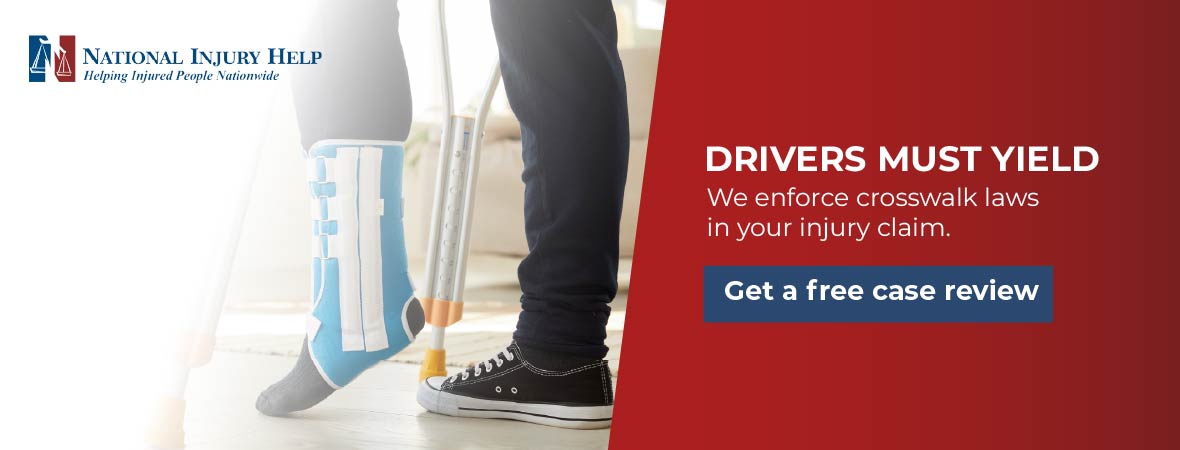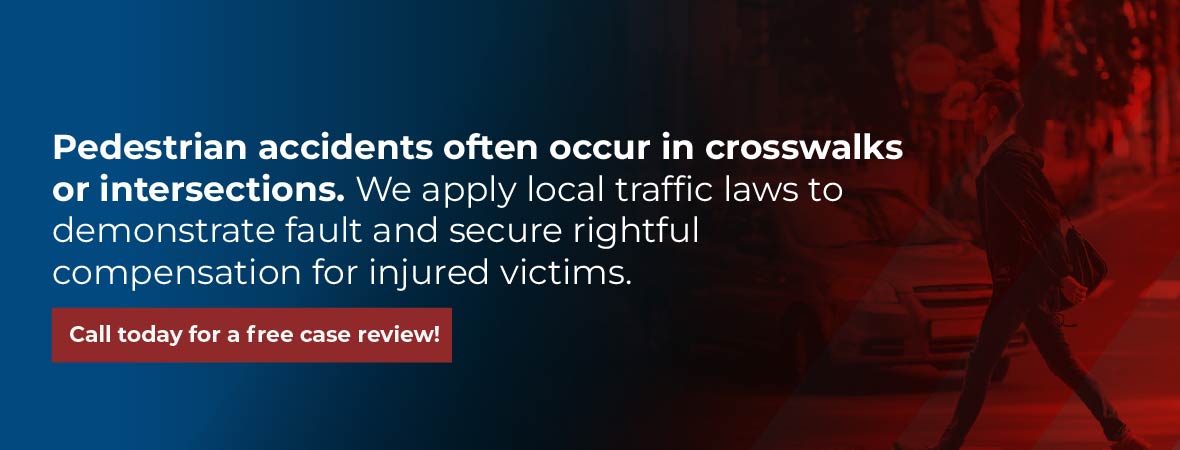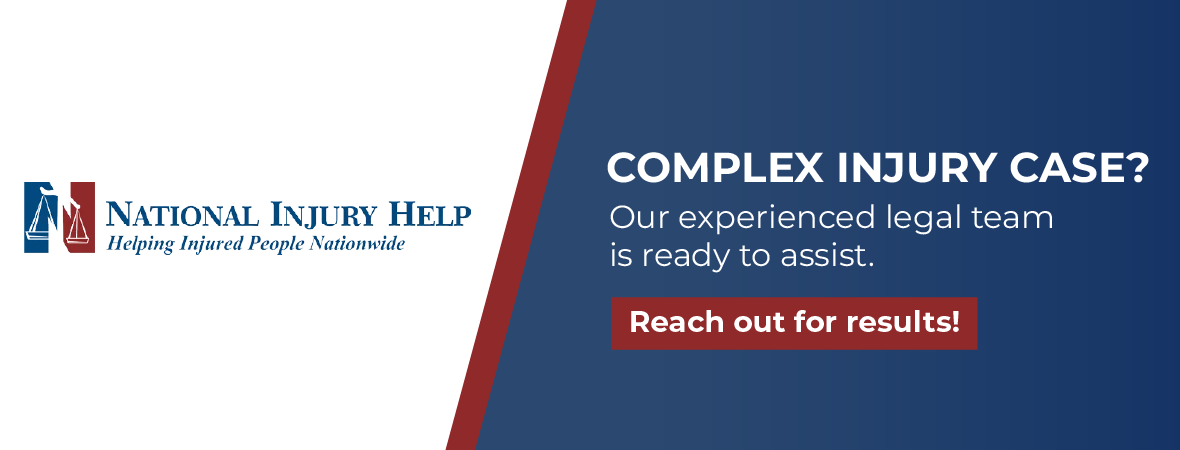Accidents at crosswalks and intersections often lead to serious injuries, especially for pedestrians. If you were injured while crossing the street or at an intersection, contact National Injury Help. We are ready to protect your rights and fight for justice.
Every day across America, people walk, bike, and drive through intersections. Most trips through these busy junctions conclude without incident. However, some do not. Thousands of crashes occur each year at intersections and crosswalks, with many of these accidents resulting in serious injuries or even fatalities.
It only takes one distracted driver or one misstep by a pedestrian for lives to change in a split second. Understanding the rules that apply at crosswalks and intersections helps reduce these risks. It also helps determine who is responsible if something does go wrong.
What Counts as a Crosswalk?
When most people hear the word “crosswalk,” they immediately picture painted white lines stretching across the road, those familiar stripes that signal where pedestrians are supposed to walk.
But in legal terms, a crosswalk includes more than just what’s marked with paint. Many areas are legally considered crosswalks even if there are no visible signs or stripes at all.
Marked Crosswalks
Marked crosswalks are the most obvious and easiest to recognize. They usually appear as solid white lines, diagonal stripes (sometimes called “zebra” stripes), or a combination of both, painted on the pavement to guide foot traffic across the street.
You’ll often find these at intersections with stop signs or traffic signals, especially in high-foot-traffic areas like downtown streets, school zones, and near public transportation hubs. Some marked crosswalks come with added features such as flashing lights, pedestrian countdown timers, or in-ground lighting to increase visibility and help drivers see people crossing.
Unmarked Crosswalks
Less visible, but just as important, are unmarked crosswalks. These don’t have painted lines or signs, but still legally exist in many places. If two streets intersect and there are sidewalks on both sides, the area connecting the sidewalks across the intersection is considered an unmarked crosswalk.
This means that if a pedestrian steps off the curb at a corner where no crosswalk is painted, they may still have the same legal right-of-way protections as someone using a clearly marked crosswalk.
What many drivers don’t realize is that crosswalk laws often treat pedestrians in unmarked crosswalks just as they treat those in marked ones. Failing to yield in these areas can still result in liability if a crash occurs.
For pedestrians, this means that crossing at an intersection, painted or not, usually comes with a layer of legal protection. Knowing this distinction can make a big difference in how responsibility is assigned after an accident.
Right-of-Way Rules: Who Goes First?
Understanding right-of-way rules is essential for both drivers and pedestrians. Not only can it help prevent serious accidents, but it also plays a key role in determining who is legally at fault and who may receive compensation if someone gets hurt.
While these rules may seem straightforward, real-life situations are often more complicated. Knowing when to yield and when you have the legal right to proceed can protect your safety and your legal rights.
When Pedestrians Have the Right of Way
Pedestrian safety laws are given priority in many situations, especially in crosswalks. If a person enters either a marked or unmarked crosswalk while the traffic light is green or the pedestrian signal reads “WALK,” drivers must stop and allow them to cross. This applies whether the crosswalk has flashing lights or is simply painted across the road.
Even at intersections without any traffic signals, pedestrians still have rights. If someone is walking in your lane or in a nearby lane, you are legally required to yield. The goal here is to give pedestrians safe passage across the street without forcing them to dodge traffic or sprint across.
Drivers turning left or right must also watch for people in the crosswalk. Just because the driver has a green light doesn’t mean they can turn without checking. If someone is already crossing, the driver has to wait until the pedestrian reaches safety before making the turn.
When Vehicles Have the Right of Way
There are also moments when pedestrians must yield to vehicles. For example, a pedestrian should not suddenly step off the curb into the path of an oncoming car. If a driver is too close to stop safely, the pedestrian must wait until it’s clear. Jumping into traffic, even in a crosswalk, can make the pedestrian partly responsible if an accident occurs.
Similarly, if someone crosses during a red light or when the “DON’T WALK” signal is flashing, they’re violating traffic laws and could be found at fault for any resulting injuries. Insurance companies and courts may reduce compensation if it’s determined that the pedestrian acted recklessly.
There are also situations where drivers may legally continue through an intersection. For example, if a driver has already entered an intersection and the light turns yellow or red, they are allowed to complete their turn, assuming the crosswalk is empty.
It’s Not Always Black and White
Right-of-way laws are designed to create order and reduce confusion, especially at busy intersections. But real-world crashes don’t always follow a perfect script. Sometimes a pedestrian is distracted, and sometimes a driver isn’t paying attention. In many cases, both parties share some level of responsibility.
That’s why evidence, such as witness statements, traffic camera footage, or police reports, can be critical. They help paint a clearer picture of who was truly at fault, and by how much. Whether you’re walking or driving, knowing the rules and staying alert can protect your health and your case if something goes wrong.
What Is Jaywalking?
Jaywalking means crossing a street outside of a crosswalk or ignoring crossing signals. While the term “jaywalking” is not used in every state’s legal code, the behavior it describes is often a civil traffic offense.
If a pedestrian crosses outside of a marked or unmarked crosswalk or crosses against a red hand signal, they may receive a ticket. In many cities, the fine can be $50 to $150 or more.
Jaywalking does more than affect your wallet. If you are hit while jaywalking, you may receive less compensation in a lawsuit because you were partly at fault. Every state has its own rules on how much fault reduces a settlement, but in most cases, the more blame you share, the less money you can recover.
Accidents at Intersections: Who Is at Fault?
Crashes at intersections are among the most common and the most complex types of traffic accidents. When a pedestrian is hit while crossing the street or two vehicles collide in the middle of an intersection, it’s not always clear who is to blame.
Accidents happen in a matter of seconds, and eyewitnesses often give conflicting accounts. What one person sees may not match what another remembers, especially when emotions are high and details are fuzzy.
Take a common example: A pedestrian begins crossing the street just as the signal starts flashing red. There are only two seconds left on the countdown, but they try to make it across anyway.
At that exact moment, a driver speeds up, trying to make it through a yellow light before it turns red. The two meet in the middle of the intersection, and suddenly, a routine commute turns into a serious crash.
So, who is at fault?
In this scenario, both the pedestrian and the driver may share some responsibility. Jaywalking liability can occur if a pedestrian walks against the signal, which means they weren’t legally supposed to enter the crosswalk. But the driver may also be at fault for accelerating into the intersection instead of slowing down, especially if they were exceeding the speed limit or not watching closely.
In many states, fault isn’t all or nothing. Instead, the law allows for shared responsibility, also known as comparative negligence. That means fault can be split between the people involved. For example, an insurance adjuster or a jury might decide that the pedestrian was 30% responsible and the driver was 70% responsible. If the pedestrian was seeking $100,000 in damages, that 30% share would reduce their payout to $70,000.
Sorting out fault in intersection accidents often depends on the available evidence. Traffic camera footage, police reports, skid marks, eyewitness statements, and even cell phone data can all help piece together what happened and who contributed most to the crash.
Because these cases can be legally complex and emotionally difficult, it’s important for anyone involved in an intersection accident, whether on foot or behind the wheel, to get legal advice early. An experienced attorney can help gather the right evidence, deal with insurance adjusters, and make sure your side of the story is heard. Understanding how fault is determined is a crucial first step toward getting the compensation you deserve.
Contact a Pedestrian Accident Lawyer
Crosswalks and intersections are some of the most dangerous places on our roads. One mistake can lead to life-changing injuries, costly medical bills, and long legal battles. But knowing the rules and getting the right help can make a big difference.
If you are involved in a crosswalk or intersection accident, act quickly. Gather evidence, seek medical attention, and consult a lawyer who understands these cases. At National Injury Help, we are ready to assist you in taking the next step toward recovery.
Contact our team by calling 1 (800) 214-1010 or visit our website to schedule a free, no-obligation case review. Your safety, health, and future matter, and we’re here to protect them.








